 Home > News Story and Obituary Archive
Home > News Story and Obituary Archive First Person: A Night at Chicago Comics
posted January 1, 2007
First Person: A Night at Chicago Comics
posted January 1, 2007


I live in a quiet, rural town of approximately 9000, nearly two hours away from the most rudimentary comic book shop. As chance would have it, a short trip to Chicago happened to coincide with a signing by
Comic Art Editor
Todd Hignite and cartoonist
Ivan Brunetti, in support of
In the Studio: Visits with Contemporary Cartoonists and
An Anthology of Graphic Fiction, Cartoons, and True Stories, respectively, both from
Yale University Press. This was cool because for my usual slip into another city's comic book shop I would get to go to one of my favorites,
Chicago Comics. I would also get to see both Todd and Ivan, and perhaps see some people I hadn't run into in quite some time. I could even drag my brother along to take photos.

I had a great time. Ivan and Todd were there and both were in a good mood. I ran into a few people I knew in comics that were out to support the signing.
Josh Cotter, of the
AdHouse series
Skyscrapers of the Midwest had just moved into town a couple of months ago. He reported he enjoyed Chicago very much when compared to the Missouri town in which he'd previously been living. Cotter plans one more issue of
Skyscrapers before bringing that series to a close and doing a collection.

I got to meet the artist
Gary Gianni, currently doing
Prince Valiant for
King Features. He was extremely affable, and I found out he was a Chicago native, I believe recently returned. I also got to see Eric Kirsammer, who took a break from domestic duties to make a rare appearance at one of his stores (he also owns Quimby's). I hadn't seen Eric in about five years. When I lived in Chicago, my main store was the late Halley's Comix, but I also shopped in Chicago Comics and certainly it's been my stop of choice -- along with the more recently passed away legendary hole-in-the-wall Larry's on Devon -- in all visits since leaving grad school.
Chicago's an odd city when it comes to comics.
Devil's Due is there, but that's about it for semi-major comics companies since First closed down years and years ago. As for a scene,
Dan Clowes and
Jessica Abel no longer live anywhere near there and other equally well-known Chicago cartoonists are in the suburbs. Still, a younger generation is beginning to make their presence felt: people like Cotter,
Anders Nilsen and
Jeffrey Brown. Standing around Chicago Comics I felt what I felt whenever I go to something in Chicago -- it may be the most blessed arts city in America for having both artists and an audience for art, as opposed to artists and an audience of other artists. All hail the City of Big Shoulders, the Bruiser by the Lake.
*****
A Brief Talk With Todd Hignite
 TOM SPURGEON: Tell me about the re-launch of
TOM SPURGEON: Tell me about the re-launch of Comic Art
this past summer. How was the reaction to your new issue; was there anything that surprised you?
TODD HIGNITE: What I hear -- mostly from Alvin [Buenaventura, the magazine's new publisher] -- is positive. I think people appreciate what it's become. Although I occasionally get nice emails from readers, for the most part I hear directly only from those people whose opinions I value since we're close on a personal and/or professional level. I don't read blogs very much or message boards at all... sometimes I read reviews if someone tells me that I should. I get confused if I listen to many other voices other than those of folks whose work I respect, if I begin paying too much attention to comics gabbing, which is rife with the most willfully superficial misinterpretations, ulterior motives, and wrongheaded dichotomies presented as cleverly articulated, eternal truths.
SPURGEON: How much PR have you been able to do in support of In the Studio
?
HIGNITE: A number of email interviews, a few talk interviews, a couple of book signings, and a podcast.
SPURGEON: What can you tell us about how the cartoonists featured felt about the way In The Studio
turned out? Is everyone happy?
HIGNITE: I got some very heartening, well thought out comments that honestly made life worth living. I hope I didn't let anyone down. They trusted me, obviously, and I gave it my all. I'm really proud of that book -- I came away with my eyes completely opened. I like the dense structure that ultimately formed, and that it rewards many different ways of reading. Connections and affinities appear in roundabout manners, and I really like the idiosyncratic story it tells. There are overlaps and detours and it strays in many directions. It's not at all a straight narrative. That was a goal of mine, as the history of comics is a lot more muddied and complex than it's been presented. I hope that while you get a richer sense of nine particular aesthetics, the past is complicated a bit as well. The artists across the board seemed very interested in the other eight chapters, and that pleased me, given the underlying conceit of the project as a whole.
SPURGEON: I know that you went to San Diego in addition to attending this signing, which is more than any of us have seen you around before. How has it been to get out in support of these projects? Do you have any interesting stories about meeting cartoonists or readers of your work? Do you plan on keeping a higher personal profile in comics from now on?
HIGNITE: It's been all right as the publicity I've taken part in has pretty much involved cartoonists I know fairly well, which makes it a lot better. It does make me feel really, really good to meet people who are genuinely given pleasure by something I've had anything to do with. I take pride in working hard on things that people value in some capacity. But I'll actually be keeping a much lower profile, if that's possible. I'll never go to San Diego again, I'm pretty sure. All I ever wanted to do was stay in my room and read comics, think about art, and do what I'm doing. I love working on books and exhibitions and putting together the magazine and seeing how it turns out each time. I'm not a distinguished conversationalist and for better or worse all I've got to offer are the finished products. Ultimately, everything comes down to the work itself and little else matters.
SPURGEON: What's it like to sit next to Ivan for two hours?
HIGNITE: Ivan's not only one of our great cartoonists -- I direct you to that last
Schizo -- but, as obvious from his
In the Studio chapter, he's absolutely the smartest guy in the room. I very much enjoy his gentle company.
*****
Photos From The Signing
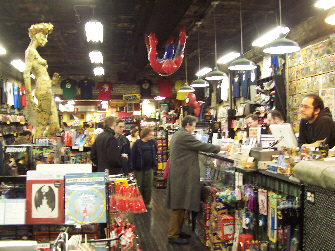 this is looking from right to the right of the front door and all the way back towards the end of the shop. The cash register area has people sitting behind it on the right, there.
this is looking from right to the right of the front door and all the way back towards the end of the shop. The cash register area has people sitting behind it on the right, there.
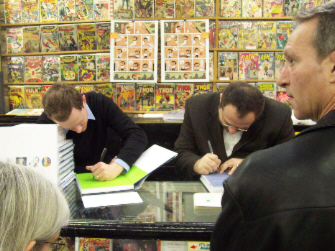 classic signing shot for both Hignite and Brunetti. The pair were behind a glass counter. You can see Ivan's print hung up behind the pair, in front of the older back issue wall.
classic signing shot for both Hignite and Brunetti. The pair were behind a glass counter. You can see Ivan's print hung up behind the pair, in front of the older back issue wall.
 if I had to guess, it looked like Brunetti may have drawn more interest than Hignite, which makes sense in a lot of ways. For one thing, Brunetti had more items to purchase, some of which you can see spread out to the right of the picture.
if I had to guess, it looked like Brunetti may have drawn more interest than Hignite, which makes sense in a lot of ways. For one thing, Brunetti had more items to purchase, some of which you can see spread out to the right of the picture.
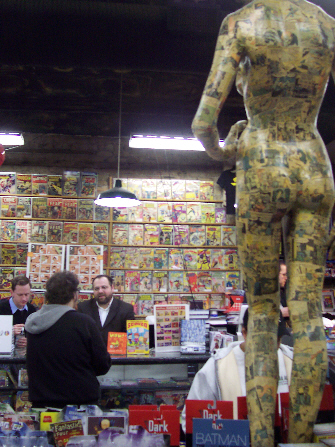 this shot gives you a better sense of the width of the store -- Whit took it from near the opposite wall -- and it gives you a look at the size of the wall of old collector's comics. Between those comics and their sturdy back-issue island, I always thought Chicago Comcis did a pretty good job keeping some back issues on hand without the place becoming overwhelmed by them.
this shot gives you a better sense of the width of the store -- Whit took it from near the opposite wall -- and it gives you a look at the size of the wall of old collector's comics. Between those comics and their sturdy back-issue island, I always thought Chicago Comcis did a pretty good job keeping some back issues on hand without the place becoming overwhelmed by them.
 the thing that jumps out at me here is Chicago Comics' basic but highly functional light setup. It's weird that you don't think of the ceilings being so high, but you certainly feel the extra space.
the thing that jumps out at me here is Chicago Comics' basic but highly functional light setup. It's weird that you don't think of the ceilings being so high, but you certainly feel the extra space.
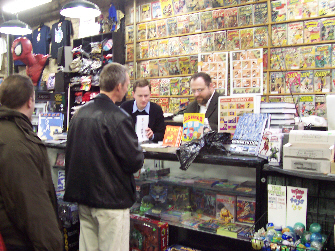


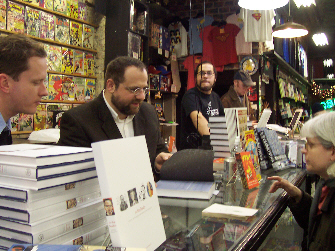 these four seem to me pretty standard shots of two cartoonists working their audience. Ivan joked beforehand that no one there was there for the signing -- and he was right in that the place was completely packed, being the Saturday nine days before Christmas. Nonetheless, the pair had a steady stream of traffic throughout.
these four seem to me pretty standard shots of two cartoonists working their audience. Ivan joked beforehand that no one there was there for the signing -- and he was right in that the place was completely packed, being the Saturday nine days before Christmas. Nonetheless, the pair had a steady stream of traffic throughout.
 this is one of Ivan Brunetti's former students
this is one of Ivan Brunetti's former students
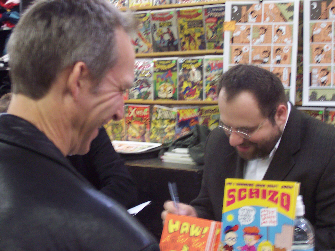 it was a very polite crowd, a bit older than any remaining patronage in the store, but no one strange or otherworldly. In terms of the man/woman breakdown I'd say about a two to one ratio.
it was a very polite crowd, a bit older than any remaining patronage in the store, but no one strange or otherworldly. In terms of the man/woman breakdown I'd say about a two to one ratio.
*****
A Brief Talk With Ivan Brunetti
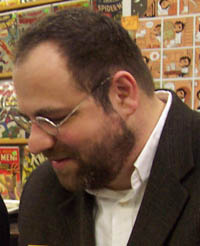 TOM SPURGEON: Ivan, I couldn't even remember it without your help, but you released a new issue of
TOM SPURGEON: Ivan, I couldn't even remember it without your help, but you released a new issue of Schizo
this year. It seemed in many ways radically different than the work that preceded it. What was the reaction like to this newer work?
IVAN BRUNETTI: Generally positive, if emails are an indicator. Sure, there was the occasional grousing I saw on various websites that shall remain nameless, but you can't please everybody. I only draw stuff to please myself, and I'm blessed with a publisher that allows me to do that. I suppose if enough people stop buying my comics, then I will not be so blessed. So be it. I would still draw the comics for my own edification, enjoyment, and/or therapy.
SPURGEON: Did anyone really in love with your older work come to you with that old "you used to be funny" line or anything like that?
BRUNETTI: Surprisingly, no. Not to my face anyway. But I'm sure people commented on it behind my back, in the world of comic-cons, message boards, blogs, and stuff like that. People that think this way probably didn't truly understand my older work, anyway, so I say GOOD RIDDANCE.
SPURGEON: Is it possible for you to briefly talk about how you went about selecting the works? Did you start with works or cartoonists, and if you started with cartoonists, how did you decide which one was the one that should be included? For instance, did you know you always wanted "Flies on the Ceiling," or did you know you wanted some Jaime Hernandez and "Flies on the Ceiling" just made sense once you thought about it?
BRUNETTI: I wrote up a proposal for Yale University Press that listed all the artists and the specific stories I wanted to include. This was back in August 2004. Of course, in the process of putting together the book, many things changed. But it's fairly close to my original vision. I probably needed 400 more pages to get it exactly perfect, but I did the best I could to include a good cross-section that felt cohesive and unified.
SPURGEON: Was there anyone excluded because you couldn't find the right work or because, say, the work you wanted> was committed elsewhere?
BRUNETTI: A couple of artists did not wish to reprint the specific stories I requested, even if I begged, so I respected their wishes. In those cases, we found an alternative that we were both happy with. In one case, the story needed to be printed with PMS colors, and we couldn't do that, so again, we found a compromise. And there was one story that had been committed to another anthology, so once again I suggested an alternative. The page count fluctuated a bit (I had gone way over what was alloted), so there were other compromises, such as my not including a lot of historical material I had originally wanted in the book. In some cases, the work was prohibitively expensive to reprint, or I couldn't get the rights in time, so that stuff ended up being cut as well. And as the book came more and more into focus, in some cases I ended up choosing stories from the artists that were different from my original proposal. I put a lot of effort into having the stories flow smoothly and interconnect. There are themes that run throughout the book. So, it was an organic process, but I had worked up a solid template to start with.
SPURGEON: Can you repeat the story about how the book got its title? You originally had another name in mind.
BRUNETTI: Yale always wanted to call the book "An Anthology of Graphic Fiction." I suggested "An Anthology of Comics," but that didn't fly. Some artists were unhappy with the term "Fiction," as they felt it mischaracterized their work (I tried apologizing for all this in the Introduction). So then I suggested "An Anthology of Fiction and Non-Fiction," which again didn't fly. (Apparently, having "Non-Fiction" in the title is not always a boost to sales.) My editor suggested the complete and exhaustive title "An Anthology of Graphic Fiction, Cartoons, and True Stories," which pretty much covered everything. I liked it, because it had a bit of humor to it, and also because then we didn't need to have any blurbs, quotes, or other text descriptions on the dustjacket, and we could just have Seth's comics and art.
SPURGEON: What do you think separates your book from other anthologies out there right now. Is there a different sensibility at work? Just a different editorial point of view?
BRUNETTI: The book reflects my tastes, certainly, but I hope that, even if there are disagreements with my choices, the readers will find them to be at least interesting and well-informed. I am attracted to certain themes, of course, and those recur throughout the book. I was really inspired by the careful organization of
McSweeney's 13 and
RAW magazine. I think what distinguishes the book from many other anthologies, especially those from academic presses, is that it allows the readers to discern the structure of my vision of comics simply from the arrangement and flow of the stories, how each artist connects to all the others. And the implicit editorial views and theories are there without my having to explicitly state them and beat the readers over the head. The structure and "flow" are the aspects of the book on which I worked the hardest and of which I am the most proud.
I also want to add that the artists and stories in the book are all dear to me, and they've all inspired me. I hope that this translates to the readers as well. I was deeply humbled by the generosity of the artists, and it was an honor for me to include all of this work in the book.
*****
Photos Taken In and Around Chicago Comics, Part One
 this is a shot from about the middle of the store; I think that's a manga shelf in the immediate foreground
this is a shot from about the middle of the store; I think that's a manga shelf in the immediate foreground
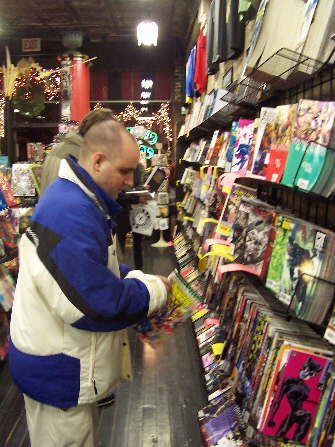 the store's big racking show-stopper is a large wall for new releases that runs along the left-hand side of the store as you walk in
the store's big racking show-stopper is a large wall for new releases that runs along the left-hand side of the store as you walk in
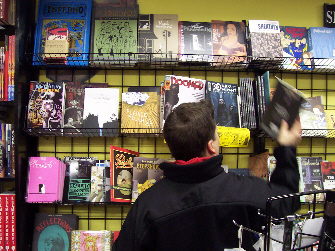 here's a look at someone facing a section of that wall
here's a look at someone facing a section of that wall
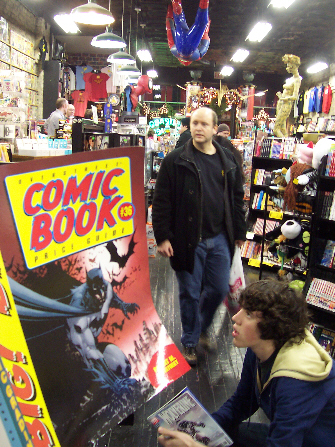 a lot of additional racking comes in the center of the store, on a series of chest high shelves -- this includes the manga, and a section featuring local, prominent cartoonists
a lot of additional racking comes in the center of the store, on a series of chest high shelves -- this includes the manga, and a section featuring local, prominent cartoonists
 this is towards the front of the store, where at lot of top-end new releases are put. to the left of the photo is a kind of general audience and strips section, which is nice because it's near the front of the store and there's not a lot of walk-through traffic to that section
this is towards the front of the store, where at lot of top-end new releases are put. to the left of the photo is a kind of general audience and strips section, which is nice because it's near the front of the store and there's not a lot of walk-through traffic to that section
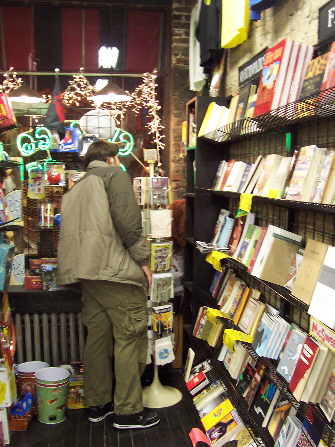 the section of the main wall that is closest to the door holds a lot of alt-lit books
the section of the main wall that is closest to the door holds a lot of alt-lit books
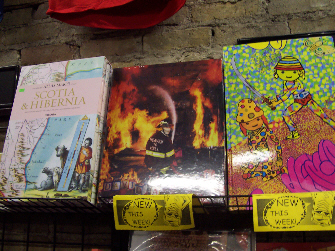 like many comics shops, Chicago Comics tags new releases. Since the visual overload of a wall full of comics can burn the eyes from your head, this is handy
like many comics shops, Chicago Comics tags new releases. Since the visual overload of a wall full of comics can burn the eyes from your head, this is handy
 some examples of rough groupings to be found in this section
some examples of rough groupings to be found in this section
*****
A Few Words With Chicago Comics Owner Eric Kirsammer
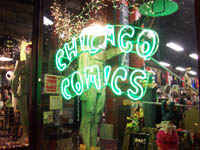 TOM SPURGEON: I know you celebrated a 15-year anniversary this year, but what exactly did that anniversary represent?
TOM SPURGEON: I know you celebrated a 15-year anniversary this year, but what exactly did that anniversary represent?
ERIC KIRSAMMER: Tom, the 15-year anniversary was to celebrate my owning the store for that long. I think it opened in 1986? Quimby's opened in the same year that I bought Chicago Comics. We used to be down the street and moved into our current location in 1993.
SPURGEON: How much of your success can be attributed to local factors, do you think? Did you benefit in any way from being able to outlast other prominent northside Chicago comics retailers like Halley's Comix and Moondog's?
KIRSAMMER: Thats a big question. Other stores closing has helped us at one time or another (due to people wanting books immediately after their store closed). But it also did not help us because a lot of people probably stopped reading after the store nearest them closed. I think we got customers from people shopping multiple stores so we were able to sell them something they could not find.
SPURGEON: Eric, does your current high-ceilinged, well-liked physical space provide your store with an advantage?
KIRSAMMER: I think the space and location has helped us. Regular people are comfortable coming into the store. We also made it have more of a professional feel with the brick walls and tin ceiling. It looks like it will be around for a while. It's a memorable store.
SPURGEON: What are some specific keys to being successful in Chicago as opposed to anywhere else?
KIRSAMMER: Keys to being successful are location, selection and in Chicago maybe authenticity? Customers can tell when you are locally owned or part of some big corporation with salespeople who do not know the product.
An interesting aspect to the location question is the changing nature of neighborhoods, especially in Chicago which has undergone a lot of gentrification. Our location now might not be the best because the neighborhood has gotten a lot more expensive to live in.
SPURGEON: How much do you feel your store has benefited or been hurt by the general upswing in popularity in comics the last couple of years, and what do you feel a store must do to catch the general, rising tide as opposed to, say, losing all of your business to Border's?
KIRSAMMER: The store has benefited from the upswing to some degree. Its hard to say. When there is an article about comics in the paper some people come to the store but a lot probably go to a regular bookstore.
To survive, I would say you have to out-superstore the superstores. You need a better selection, more knowledgeable staff and overall better service. The superstores cannot compete with a well-run comic book specialty store. Our staff will always know more than their staff and be more committed to the product.
*****
Photos Taken In and Around Chicago Comics, Part II
 I didn't even notice this thing the entire time I was in there, which is sort of sad
I didn't even notice this thing the entire time I was in there, which is sort of sad
 this action figure kept shoving the Tupac Shakur action figure off of the shelves
this action figure kept shoving the Tupac Shakur action figure off of the shelves
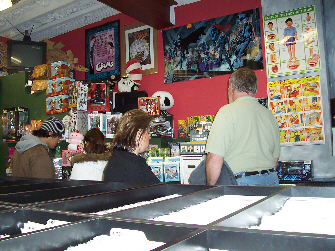 a shot over the back-issues bins at the back of the store
a shot over the back-issues bins at the back of the store
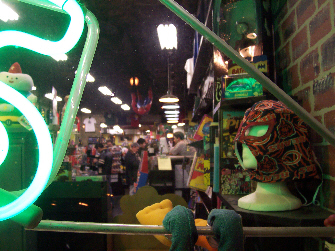 from the outside looking in
from the outside looking in
 there seemed to me a whole lot of these high-end boutique-type toys and action figures
there seemed to me a whole lot of these high-end boutique-type toys and action figures
 just in case you had any doubts Chicago Comics was in an urban neighborhood, here are the fliers to prove it. I didn't even know they did fliers anymore, actually
just in case you had any doubts Chicago Comics was in an urban neighborhood, here are the fliers to prove it. I didn't even know they did fliers anymore, actually
 this is what a person that doesn't want to be at Chicago Comics will see as they gaze out into the street
this is what a person that doesn't want to be at Chicago Comics will see as they gaze out into the street
 Clark at this point is a busy, but not incredibly busy street foot traffic-wise. It's still a destination neighborhood, though, and the train is a block and a half away. We got a ticket
Clark at this point is a busy, but not incredibly busy street foot traffic-wise. It's still a destination neighborhood, though, and the train is a block and a half away. We got a ticket
*****
A Brief Talk With Chicago Comics Manager Eric Thornton
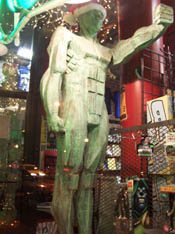 TOM SPURGEON: Can you talk a bit about your decision to move the alt-comics to the back and have alt-lit and then superheroes on your big wall? I know that decision was made years ago, but 1) I know you've been around for several years, 2) it's something that people keep asking me about when your store's name comes up, and 3) I wondered in general how you decided what goes where.
TOM SPURGEON: Can you talk a bit about your decision to move the alt-comics to the back and have alt-lit and then superheroes on your big wall? I know that decision was made years ago, but 1) I know you've been around for several years, 2) it's something that people keep asking me about when your store's name comes up, and 3) I wondered in general how you decided what goes where.
ERIC THORNTON: This is simple, and not nearly as conspiratorial as some would like to believe. It was a space issue. There were just more and more collections being printing (and are still being printed) everyday, and it was getting to the point where we were
not carrying stuff because it would mean kicking something else good out. It was a battle between two genres that wasn't going to have a clear cut winner. So, either Superhero was going into the back or Small Press was. And we pay a lot more bills with superhero comics, unfortunately.
Where the books are now, small press actually has its own "room": the old Manga/Foreign room. And now, we're able to keep the mini comics and zines in the same section, which is something I always wanted to do, but just was not able to pull off. The idea of minis being at the complete opposite end of the store from small press always bothered me. But, yeah, even though Small Press has actually
more room and we're able to carry
more Small Press stuff, a lot of people looked at it as if it was a snub to indy comics, when in fact it allowed us to carry even more indy press. But people see what they want to see, I guess...
SPURGEON: Do you buy anything directly from publishers? If so, how much and why?
THORNTON: Oh, yeah. All the time. In some cases, though, it's more headaches than it's worth.
D&Q has absurd minimums, so we quit doing it through them,but they've got the whole Canada/US thing going on, so it's a different field. But
Fanta stuff we get direct from them. On the flip side, you have guys like
Chris Staros at Top Shelf, who doesn't
want us to order direct, because he'd rather have the
Diamond numbers. So, yeah, it really depends on a case by case basis.
SPURGEON: What about book distributors?
THORNTON: Again, yes, quite a bit.
Ingram,
Bookazine, VHPS are the big ones. The percentage and merchandise is pretty much our fiction/artbook section. I rarely get something comic related from those guys, which I know some retailers do, for the returnability aspect. But I love a bigger discount more than a safety net.
SPURGEON: You have a substantial but not complete manga section. Who buys your manga, and how do you decided what to sell and what not to sell. Is there any series that sells in your store that might surprise people?
THORNTON: A
complete manga section would be, honestly, half the store. Manga is still something we are learning how to sell, even 10 years into carrying it. It's the most fickle comic genre I've ever seen. Something on fire one year will not sell a single copy the next year. it extremely frustrating. Basically, our rule with manga is, if it sells, get it back in. If it doesn't, bail out as quick as you can.
SPURGEON: Do you see a market downturn at any point in the future, near or far?
THORNTON: I've heard people saying a downturn is coming for 25 years now. And here we all still are. New readers, contrary to popular belief, are still coming in all the time. Literate young readers who want to catch up, and good lord, is there a lot of catching up to do at this point.
Dan Clowes' stuff will always blow you away if you've never read it. There's a new 16-year-old every day who finally realizes what this art form can offer. Everyone I know who says comics are dying don't buy comics anymore, except for your occasional
CC Beck retrospective or whatever. It's not the marketplace that's dying, it's their passion that's on the downturn. Comics are a medium, not a fad. Fads die. Mediums rarely do.
*****
A Brief Encounter With a Bill Mauldin Original

It broke my heart that I didn't end up having time to go to the
Bill Mauldin exhibit at the Jean Ablano Gallery. Mauldin's a 20th Century art hero, and I hadn't seen an original of his before.
The reason I had come to Chicago for the weekend was to see my older brother Whit act in
Neil Giuntoli's play at the
Prop Theatre,
Hizzoner, about the last of the great "boss" mayors,
Richard J. Daley. Going to the theater with one of the actors, I had some extra lobby time. There's some great comics related stuff on the theater's walls: a poster for a show done by poet and painter
Tony Fitzpatrick, a
Mitch O'Connell original depicting their latest physical space, and a giant poster of an
R. Crumb exhibition in Haarlem signed by Crumb. But the best thing was in the lobby where audience members waited for the house to open.
In that lobby was an array of Daley-related materials, including the above cartoon. It was an original Bill Mauldin. I could no longer make out the sentence preceding the signature, but it had been signed to someone, my guess the same person that had lent it to the Theatre for the production. It was large, about 18 inches tall by 14 inches wide. The cartoon was attractive, done with very little in the way of visible changes, and the drawing itself was mean and funny. Although best known and rightfully so for his World War II
Willie and Joe cartoons, Mauldin had a second career -- or somewhere between a third and seventh depending on how you count -- as one of America's most valuable and consistently excellent political cartoonists. And with the Daley Family in power in Chicago, Mauldin certainly had the kind of presumptuous lords of the city against which he could inveigh. Mauldin had famously gone toe to toe with General George Patton; I can't imagine he was that impressed with the former Bridgeport neighborhood alderman.
Mauldin's work is going to be the focal point of a major publishing effort by Fantagraphics, which hopefully will help restore his legacy not among the locals and soldiers who experienced his work first hand and came to love it, but among comics fans who have until now been slightly out of the loop.
Anyway, seeing the work was a very pleasant surprise.
*****
Mug shots are all by Whit Spurgeon, and are Josh Cotter, Gary Gianni, Todd Hignite, and Ivan Brunetti. A picture of the Chicago Comics neon sign is the insert in Eric Kirsammer's chat; Eric Thornton's insert is a flip-over of a statue in the window.
*****
*
An Anthology of Graphic Fiction, Cartoons, and True Stories, Ivan Brunetti, Yale University Press, Hardcover, 400 pages, 0300111703 (ISBN), October 2006, $28.
*
In the Studio: Visits with Contemporary Cartoonists, Todd Hignite, Yale University Press, Hardcover, 320 pages, 0300110162 (ISBN), October 2006, $29.95.
*****
*****


